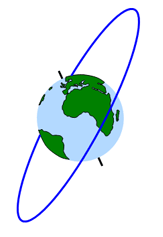Geosynchronous orbit
From Halopedia, the Halo wiki
| This article does not have enough inline citations and/or does not adhere to the proper citation format. You can help Halopedia by adding citations. |
A geosynchronous orbit is an orbit around a planet with an orbital period matching the planet's sidereal rotation period.
This synchronization means that for an observer at a fixed location on Earth, a satellite in a geosynchronous orbit returns to exactly the same place in the sky at exactly the same time each day. In principle, any orbit with a period equal to the planet's rotational period is technically geosynchronous, however, the term is almost always used to refer to the special case of a geosynchronous orbit that is circular (or nearly circular) and at zero (or nearly zero) inclination, that is, directly above the equator. This is sometimes called a geostationary orbit. [1].
Orbital Defence Platforms in particular make use of geostationary orbits to protect certain ground regions from attack; Cairo Station, for example, orbited directly over the city of Cairo, taking its name. The Athens Station also orbited above the Greek city of Athens. Other satellites orbit in traditional geosynchronous orbits, returning to the same point in orbit every rotation of the Earth.
Sources
- ^ V. Chobotov, ed., (1996) Orbital Mechanics, 2nd edition, AIAA Education Series, p. 304.
